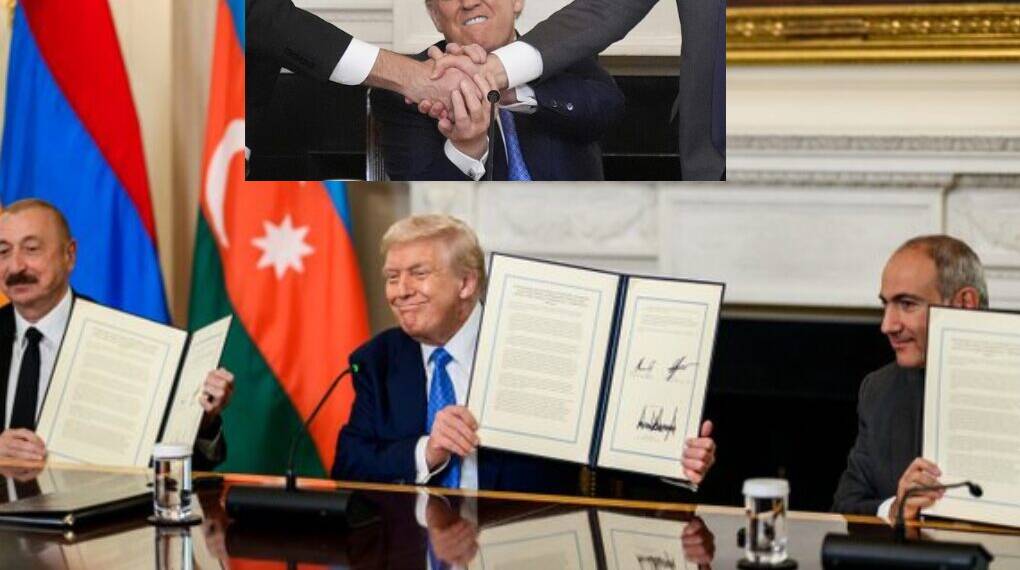In a landmark diplomatic breakthrough, the leaders of Armenia and Azerbaijan shook hands Friday at the White House, signing a sweeping peace agreement aimed at ending decades of bitter conflict over the Nagorno-Karabakh region.
President Donald Trump stood between Azerbaijani President Ilham Aliyev and Armenian Prime Minister Nikol Pashinyan as the two adversaries clasped hands, with Trump placing his own hands over theirs in a symbolic gesture of unity.
The U.S.-brokered accord not only normalizes relations between the South Caucasus rivals but also creates a major transportation and energy corridor — to be officially named the Trump Route for International Peace and Prosperity.
Breaking a 35-Year Stalemate
For more than three decades, Armenia and Azerbaijan were locked in cycles of violence over Nagorno-Karabakh, a mountainous enclave internationally recognized as part of Azerbaijan but historically populated by ethnic Armenians. Despite multiple ceasefires and mediation attempts, tensions repeatedly boiled over into war, most recently in 2020 and again in 2023, when Azerbaijan regained full control of the region.
Trump hailed the agreement as a “great honor” and a “miracle” of diplomacy. “Thirty-five years they fought, and now they’re friends,” he said. Both Aliyev and Pashinyan credited Trump personally for the breakthrough, with Aliyev calling the deal “a miracle in six months” and Pashinyan describing it as “a significant milestone” for the region.
The Trump Route: Strategic and Symbolic
The central feature of the deal is the creation of the Trump Route, a 32-kilometer corridor connecting Azerbaijan to its Nakhchivan exclave through Armenian territory. The route — which will include a rail line, oil and gas pipelines, and fiber optic cables — will be developed under U.S. leadership, with negotiations involving at least nine interested firms set to begin next week.
For Azerbaijan, the corridor ensures direct access to Turkey and Europe, strengthening its role as an energy hub. For Armenia, retaining sovereignty over the land while leasing development rights to U.S.-backed companies for 99 years provides economic opportunity while easing security concerns.
Winners on All Sides
Armenia
Establishes full diplomatic normalization with Azerbaijan and the U.S.
Gains access to U.S. economic partnerships and infrastructure investment.
Retains sovereignty over the Zangezur Corridor while ensuring peace and avoiding regional isolation.
Azerbaijan
Secures uninterrupted territorial continuity through the corridor.
Receives a U.S. waiver of Section 907 of the Freedom Support Act, opening avenues for military cooperation.
Gains independence from Russian- and OSCE-led mediation efforts.
United States
Scores a major foreign policy win in a historically volatile region.
Gains exclusive rights to develop a strategic trade and energy link between Europe and Asia.
Counters Russian and Iranian influence in the South Caucasus.
Geopolitical Ripple Effect
The deal marks a significant shift in the region’s balance of power, diminishing Russia’s traditional role as the primary mediator between Armenia and Azerbaijan. Moscow’s influence has waned sharply since its 2022 invasion of Ukraine, opening the door for Washington to step in.
Trump’s administration has also facilitated recent agreements between other long-standing adversaries, including the Democratic Republic of Congo and Rwanda, and mediated ceasefires in South Asia and Southeast Asia. While challenges remain in other hotspots like Gaza and Ukraine, Friday’s signing adds to the White House’s growing record of conflict resolution.
As Trump put it: “Many leaders have tried to end the war, with no success — until now.”








